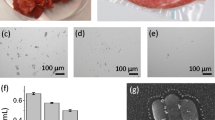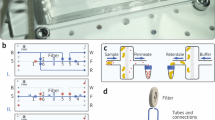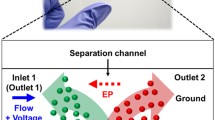Abstract
This study addresses the challenge of separating bacteria with similar structures such as Escherichia coli and Aeromonas hydrophila. This approach employs pulsed field dielectrophoresis assisted by laminar flow fractionation in a lab-on-a-chip system with integrated optical detection. Bacterial cells passed through 30-µm microelectrodes subjected at 1 MHz and 14 V peak-to-peak in pulsed mode, while fluid flow carried bacteria towards the chamber’s end. The on-and-off electric field at specific pulse intervals expose bacterial cells to diverse forces, including kinetics, dielectrophoresis, gravity, drag, and diffusion, resulting in a net force facilitating their movement. Variations of pulsing time, flow rates, and voltage were investigated to identify the optimal combination for efficient separation. Next, the bacteria were detected using an optical fibre based on their absorbance. Results demonstrated a 30% separation efficiency in 90 min at 9.6 μL min−1 flow rates, 4 s pulsing time, and 40 μS cm−1 medium conductivity. A. hydrophila aggregates experienced greater DEP force and retained at microelectrodes during electric field application compared to E. coli, which moved faster towards optical detection. The separation mechanism with and without electric field was different, and precise control of cell movement during field-off periods is important to minimize uncontrolled diffusion. While the optical detection part has been successful, longer time and separation length are recommended for better separation. A carefully tuned combination of pulsing time, flow rates, voltage, and microelectrode design is crucial for this integrated lab-on-chip system to be efficient for separating and detecting closely related microorganisms.








Similar content being viewed by others
References
Li T, Wang E, Dong S (2010) Lead (II)-induced allosteric G-quadruplex DNAzyme as a colorimetric and chemiluminescence sensor for highly sensitive and selective Pb2+ detection. Anal Chem 82:1515–1520. https://doi.org/10.1021/ac902638v
Faye D, Lefevre JP, Delaire JA et al (2012) A selective lead sensor based on a fluorescent molecular probe grafted on a PDMS microfluidic chip. J Photochem Photobiol A Chem 234:115–122. https://doi.org/10.1016/j.jphotochem.2012.01.006
Cetin AE, Coskun AF, Galarreta BC et al (2014) Handheld high-throughput plasmonic biosensor using computational on-chip imaging. Light Sci Appl 3:e122. https://doi.org/10.1038/lsa.2014.3
Musayev J, Adlgüzel Y, Külah H et al (2014) Label-free DNA detection using a charge sensitive CMOS microarray sensor chip. IEEE Sens J 14:1608–1616. https://doi.org/10.1109/JSEN.2014.2301693
Yetisen AK, Akram MS, Lowe CR (2013) Paper-based microfluidic point-of-care diagnostic devices. Lab Chip 13:2210–2251. https://doi.org/10.1039/C3LC50169H
Merola F, Memmolo P, Miccio L et al (2015) Diagnostic tools for lab-on-chip applications based on coherent imaging microscopy. Proc IEEE 103:192–204. https://doi.org/10.1109/JPROC.2014.2375374
Jolly P, Rainbow J, Regoutz A et al (2019) A PNA-based lab-on-PCB diagnostic platform for rapid and high sensitivity DNA quantification. Biosens Bioelectron 123:244–250. https://doi.org/10.1016/j.bios.2018.09.006
Yamaguchi A, Fukuoka T, Takahashi R et al (2016) Dielectrophoresis-enabled surface enhanced Raman scattering on gold-decorated polystyrene microparticle in micro-optofluidic devices for high-sensitive detection. Sens Actuators B Chem 230:94–100. https://doi.org/10.1016/j.snb.2016.02.023
Ohlsson P, Evander M, Petersson K et al (2016) Integrated acoustic separation, enrichment, and microchip polymerase chain reaction detection of bacteria from blood for rapid sepsis diagnostics. Anal Chem 88:9403–9411. https://doi.org/10.1021/acs.analchem.6b00323
Pham QN, Trinh KTL, Jung SW et al (2018) Microdevice-based solid-phase polymerase chain reaction for rapid detection of pathogenic microorganisms. Biotechnol Bioeng 115:2194–2204. https://doi.org/10.1002/bit.26734
Hidi IJ, Heidler J, Weber K et al (2016) Ciprofloxacin: pH-dependent SERS signal and its detection in spiked river water using LoC-SERS. Anal Bioanal Chem 408:8393–8401. https://doi.org/10.1007/s00216-016-9957-2
Costella M, Avenas Q, Frénéa-Robin M et al (2019) Dielectrophoretic cell trapping for improved surface plasmon resonance imaging sensing. Electrophoresis 40:1417–1425. https://doi.org/10.1002/elps.201800439
Wang Z, Hansen O, Petersen PK et al (2006) Dielectrophoresis microsystem with integrated flow cytometers for on-line monitoring of sorting efficiency. Electrophoresis 27:5081–5092. https://doi.org/10.1002/elps.200600422
Wang XB, Vykoukal J, Becker FF et al (1998) Separation of polystyrene microbeads using dielectrophoretic/gravitational field-flow-fractionation. Biophys J 74:2689–2701. https://doi.org/10.1016/S0006-3495(98)77975-5
Maruyama H, Kotani K, Masuda T et al (2011) Nanomanipulation of single influenza virus using dielectrophoretic concentration and optical tweezers for single virus infection to a specific cell on a microfluidic chip. Microfluid Nanofluidics 10:1109–1117. https://doi.org/10.1007/s10404-010-0739-4
Ding J, Lawrence RM, Jones PV et al (2016) Concentration of Sindbis virus with optimized gradient insulator-based dielectrophoresis. Analyst 141:1997–2008. https://doi.org/10.1039/C5AN02430G
Bhattacharya S, Chao TC, Ariyasinghe N et al (2014) Selective trapping of single mammalian breast cancer cells by insulator-based dielectrophoresis. Anal Bioanal Chem 406:1855–1865. https://doi.org/10.1007/s00216-013-7598-2
Song Y, Yang J, Shi X et al (2012) DC dielectrophoresis separation of marine algae and particles in a microfluidic chip. Sci China Chem 55:524–530. https://doi.org/10.1007/s11426-012-4533-x
Wang X, Yang J, Gascoyne PR (1999) Role of peroxide in AC electrical field exposure effects on friend murine erythroleukemia cells during dielectrophoretic manipulations. Biochim Biophys Acta 1426:53–68. https://doi.org/10.1016/s0304-4165(98)00122-6
Huang Y, Joo S, Duhon M et al (2002) Dielectrophoretic cell separation and gene expression profiling on microelectronic chip arrays. Anal Chem 74:3362–3371. https://doi.org/10.1021/ac011273v
Esteban-Ferrer D, Edwards MA, Fumagalli L et al (2014) Electric polarization properties of single bacteria measured with electrostatic force microscopy. ACS Nano 8:9843–9849. https://doi.org/10.1021/nn5041476
Lewpiriyawong N, Kandaswamy K, Yang C et al (2011) Microfluidic characterization and continuous separation of cells and particles using conducting poly(dimethyl siloxane) electrode induced alternating current-dielectrophoresis. Anal Chem 83:9579–9585. https://doi.org/10.1021/ac202137y
Khoshmanesh K, Baratchi S, Tovar-Lopez FJ et al (2012) On-chip separation of Lactobacillus bacteria from yeasts using dielectrophoresis. Microfluid Nanofluidics 12:597–606. https://doi.org/10.1007/s10404-011-0900-8
Han CH, Woo SY, Bhardwaj J et al (2018) Rapid and selective concentration of bacteria, viruses, and proteins using alternating current signal superimposition on two coplanar electrodes. Sci Rep 8:14942. https://doi.org/10.1038/s41598-018-33329-7
Lapizco-Ecinas BH, Simmons BA, Cummings EB et al (2004) Dielectrophoretic concentration and separation of live and dead bacteria in an array of insulators. Anal Chem 76:1571–1579. https://doi.org/10.1021/ac034804j
Narji NFNM, Ahmad MR (2020) Dielectrophoresis-based microfluidic device for separation of potential cancer cells. Bull Electr Eng Inform 9:2270–2277. https://doi.org/10.11591/eei.v9i6.2224
Park J, Kim B, Choi SK et al (2005) An efficient cell separation system using 3D-asymmetric microelectrodes. Lab Chip 5:1264–1270. https://doi.org/10.1039/B506803G
An J, Lee J, Lee SH et al (2009) Separation of malignant human breast cancer epithelial cells from healthy epithelial cells using an advanced dielectrophoresis-activated cell sorter (DACS). Anal Bioanal Chem 394:801–809. https://doi.org/10.1007/s00216-009-2743-7
Kawabata T, Washizu M (2001) Dielectrophoretic detection of molecular bindings. IEEE Trans Ind Appl 37:1625–1633. https://doi.org/10.1109/28.968170
Müller T, Gradl G, Howitz S et al (1999) A 3-D microelectrode system for handling and caging single cells and particles. Biosens Bioelectron 14:247–256. https://doi.org/10.1016/S0956-5663(99)00006-8
Aldaeus F, Lin Y, Amberg G et al (2006) Multi-step dielectrophoresis for separation of particles. J Chromatogr A 1131:261–266. https://doi.org/10.1016/j.chroma.2006.07.022
Morgan H, Green NG (2003) AC electrokinetics colloids and nanoparticles. Research Studies Press
Kim MS, Sim TS, Kim YJ et al (2012) SSA-MOA: a novel CTC isolation platform using selective size amplification (SSA) and a multi-obstacle architecture (MOA) filter. Lab Chip 12:2874–2880. https://doi.org/10.1039/C2LC40065K
Okada T (2007) Field flow fractionation: electric fields. In: Wilson ID (ed) Encyclopedia of separation science. Academic Press
Abel AP, Weller MG, Duveneck GL et al (1996) Fiber-optic evanescent wave biosensor for the detection of oligonucleotides. Anal Chem 68:2905–2912. https://doi.org/10.1021/ac960071+
Wolfbeis OS (2000) Fiber-optic chemical sensors and biosensors. Anal Chem 72:81R-89R. https://doi.org/10.1021/ac060490z
Echeverría JC, Faustini M, Garrido JJ (2016) Effects of the porous texture and surface chemistry of silica xerogels on the sensitivity of fiber-optic sensors toward VOCs. Sens Actuators B Chem 222:1166–1174. https://doi.org/10.1016/j.snb.2015.08.010
Brückner M, Becker K, Popp J et al (2015) Fiber array based hyperspectral Raman imaging for chemical selective analysis of malaria-infected red blood cells. Anal Chim Acta 894:76–84. https://doi.org/10.1016/j.aca.2015.08.025
Yao BC, Wu Y, Yu CB et al (2016) Partially reduced graphene oxide based FRET on fiber-optic interferometer for biochemical detection. Sci Rep 6:23706. https://doi.org/10.1038/srep23706
Foguel MV, Ton XA, Zanoni MV et al (2015) A molecularly imprinted polymer-based evanescent wave fiber optic sensor for the detection of basic red 9 dye. Sens Actuators B Chem 218:222–228. https://doi.org/10.1016/j.snb.2015.05.007
Nguyen TT, Trinh KTL, Yoon WJ et al (2017) Integration of a microfluidic polymerase chain reaction device and surface plasmon resonance fiber sensor into an inline all-in-one platform for pathogenic bacteria detection. Sens Actuators B Chem 242:1–8. https://doi.org/10.1016/j.snb.2016.10.137
Kamuri MF, Zainal Abidin Z, Yaacob MH et al (2019) Separation and detection of Escherichia coli and Saccharomyces cerevisiae using a microfluidic device integrated with an optical fibre. Biosensors (Basel) 9:40. https://doi.org/10.3390/bios9010040
Kamuri F, Zainal Abidin Z, Yunus NAM et al (2015) Optimization on the preparation of microfluidic channel using dry film resist. In: Proceedings of 2015 international conference on smart sensors and application (ICSSA), Grand Seasons Hotel, Kuala Lumpur, 26–28 May 2015
Fu LM, Shu WE, Wang YN (2012) Particle analysis and differentiation using a photovoltaic cell. J Micromech Microeng 22:105023. https://doi.org/10.1088/0960-1317/22/10/105023
Pethig R (1996) Dielectrophoresis: using inhomogeneous AC electrical fields to separate and manipulate cells. Crit Rev Biotechnol 16:331–348. https://doi.org/10.3109/07388559609147425
Wong PK, Chen CY, Wang TH et al (2004) Electrokinetic bioprocessor for concentrating cells and molecules. Anal Chem 76:6908–6914. https://doi.org/10.1021/ac049479u
Suehiro J, Hamada R, Noutomi D et al (2003) Selective detection of viable bacteria using dielectrophoretic impedance measurement method. J Electrostat 57:157–168. https://doi.org/10.1016/S0304-3886(02)00124-9
Pethig R (2010) Review article-dielectrophoresis: status of the theory, technology, and applications. Biomicrofluidics 4:022811. https://doi.org/10.1063/1.3456626
Jones TB (2005) Electromechanics of particles. Cambridge University Press, New York
Wukitsch MW, Petterson MT, Tobler DR et al (1988) Pulse oximetry: analysis of theory, technology, and practice. J Clin Monit 4:290–301. https://doi.org/10.1007/BF01617328
Gauri S, Abidin ZZ, Kamuri MF et al (2017) Detection of Aeromonas hydrophila using fiber optic microchannel sensor. J Sens 2017:8365189. https://doi.org/10.1155/2017/8365189
Gascoyne PR, Vykoukal JV (2004) Dielectrophoresis-based sample handling in general-purpose programmable diagnostic instruments. Proc IEEE Inst Electr Electron Eng 92:22–42. https://doi.org/10.1109/JPROC.2003.820535
Acknowledgements
We would like to thank Malaysia Ministry of Science, Technology, and Innovation for funding this project (SF-02-01-04-SF1214), Majlis Amanah Rakyat (MARA) for providing student financial assistance, Dr. Zalini Yunus from Science and Technology Research Institute for Defence (STRIDE), Malaysia Ministry of Defence for providing the microbes and Mr. Ashaari Yusof from TM R&D, Malaysia for providing the technical assistance.
Author information
Authors and Affiliations
Corresponding author
Ethics declarations
Conflict of interest
The authors declare no conflict of interest.
Informed consent
Neither ethical approval nor informed consent was required for this study.
Additional information
Publisher's Note
Springer Nature remains neutral with regard to jurisdictional claims in published maps and institutional affiliations.
Rights and permissions
Springer Nature or its licensor (e.g. a society or other partner) holds exclusive rights to this article under a publishing agreement with the author(s) or other rightsholder(s); author self-archiving of the accepted manuscript version of this article is solely governed by the terms of such publishing agreement and applicable law.
About this article
Cite this article
Kamuri, M.F., Abidin, Z.Z., Yaacob, M.H. et al. Assessment of pulsed dielectrophoretic-field flow fractionation separation coupled with fibre-optic detection on a lab-on-chip as a technique to separate similar bacteria cells. Biotechnol Bioproc E 29, 141–156 (2024). https://doi.org/10.1007/s12257-024-00001-z
Received:
Revised:
Accepted:
Published:
Issue Date:
DOI: https://doi.org/10.1007/s12257-024-00001-z




